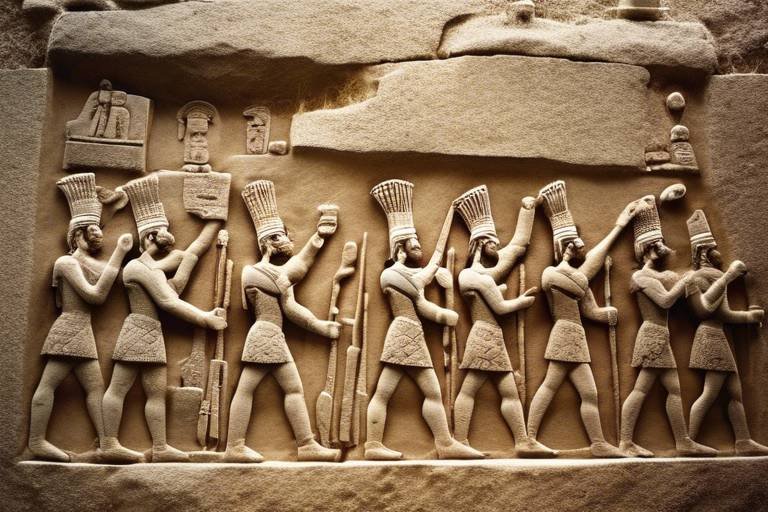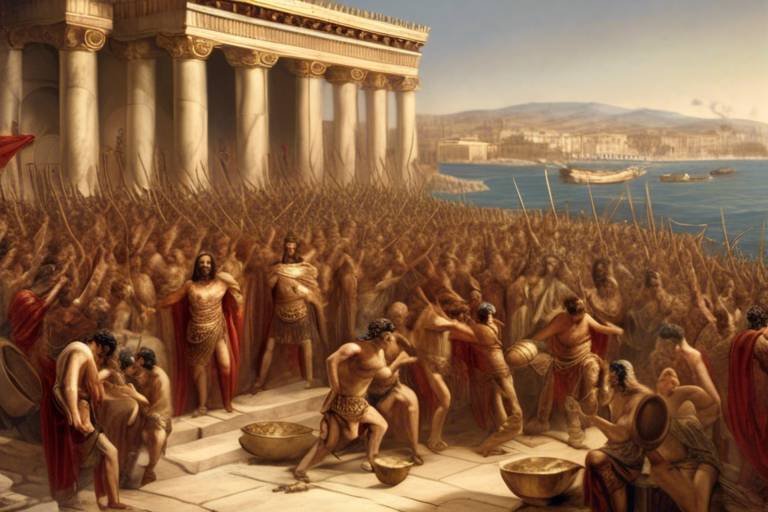The Forgotten Achievements of the Hittite Empire
The Hittite Empire, often overshadowed by other ancient civilizations, made significant contributions to history. Exploring their achievements sheds light on their advanced culture, military prowess, diplomatic skills, and technological innovations.

Hittite Culture and Society
The Hittite Empire was not only renowned for its military might but also for its rich and diverse cultural heritage. Their society was a tapestry of traditions, language, art, and religious practices that set them apart from other ancient civilizations. The Hittites spoke an Indo-European language and left behind a wealth of written records on clay tablets, providing insights into their daily life and customs.
Artistic expression flourished in the Hittite Empire, with intricate carvings adorning their temples and palaces. These artistic achievements reflected the Hittites' reverence for their deities and the natural world. Their religion played a central role in shaping their society, influencing everything from governance to social rituals.
Social structure in the Hittite Empire was hierarchical, with a ruling class overseeing the administration of the vast empire. Priests, nobles, and artisans each played a crucial role in maintaining the stability and prosperity of Hittite society. The common people, though lower in status, contributed to the economy through agriculture, craftsmanship, and trade.
Family life was paramount in Hittite culture, with strong familial ties and kinship networks forming the foundation of their society. Marriage, inheritance, and communal celebrations were integral parts of Hittite social life, reinforcing bonds between individuals and communities.
Despite the passage of time, the legacy of Hittite culture and society endures as a testament to the creativity and resilience of this ancient civilization. By exploring their cultural achievements, we gain a deeper appreciation for the complexities of Hittite life and the enduring impact they had on subsequent civilizations.

Hittite Military Strategies
The military strategies employed by the Hittite Empire were a key factor in their dominance and expansion in the ancient world. Their army was renowned for its innovative tactics and formidable strength on the battlefield.
One of the most notable aspects of Hittite military strategy was their effective use of chariots. These chariots, equipped with skilled drivers and armed warriors, provided the Hittites with a mobile and versatile fighting force. The speed and maneuverability of the chariots allowed them to outmaneuver their opponents and strike with precision, giving them a significant advantage in battle.
In addition to chariots, the Hittites were also skilled in siege warfare. They developed advanced siege techniques and weaponry to overcome fortified enemy cities. By utilizing battering rams, siege towers, and other innovative siege engines, the Hittites were able to breach enemy defenses and secure victory in sieges.
The Hittite military also excelled in the use of infantry and cavalry. Their infantry units were well-trained and equipped with effective weapons, such as spears, swords, and shields. The cavalry, on the other hand, provided speed and mobility to their forces, allowing them to launch swift attacks and flank enemy positions.
Moreover, the Hittites were adept at strategic planning and coordination of their military campaigns. They employed tactics such as ambushes, feints, and coordinated assaults to outsmart and outmaneuver their adversaries. This strategic acumen, coupled with their disciplined and well-trained army, ensured their success on the battlefield.
Overall, the Hittite military strategies were a testament to their military prowess and innovation. By combining advanced tactics, skilled warriors, and strategic planning, the Hittites established themselves as a dominant force in the ancient world, leaving a lasting legacy in the annals of military history.

Hittite Diplomacy and Alliances
The Hittite Empire, often overshadowed by other ancient civilizations, made significant contributions to history. Exploring their achievements sheds light on their advanced culture, military prowess, diplomatic skills, and technological innovations.
The Hittites were masters of diplomacy, skillfully navigating the complex web of alliances and rivalries that defined the ancient Near East. Through strategic marriages, treaties, and alliances, they secured their position as a dominant force in the region. Their diplomatic efforts were crucial in maintaining stability and expanding their influence beyond their borders.
One of the most notable alliances of the Hittite Empire was with the powerful kingdom of Egypt. This strategic partnership not only ensured mutual protection against common enemies but also facilitated trade and cultural exchange between the two empires. The Hittites were adept at forming alliances based on mutual benefit, leveraging their diplomatic acumen to strengthen their position on the international stage.
Furthermore, the Hittites established diplomatic ties with other major powers of the time, such as the Assyrians and Babylonians. These alliances were carefully crafted to balance power dynamics and prevent conflicts that could threaten the stability of the region. By fostering diplomatic relationships with both allies and rivals, the Hittites were able to navigate the volatile political landscape of the ancient world.
Through their diplomatic prowess, the Hittites were able to maintain a delicate balance of power, ensuring peace and prosperity within their empire and beyond. Their ability to forge alliances and navigate intricate political relationships set them apart as shrewd diplomats and skilled negotiators in the ancient world.

Hittite Architectural Marvels
The Hittite Empire's architectural marvels stand as a testament to their ingenuity and engineering prowess. One of the most remarkable structures is the Great Temple of Hattusa, a massive complex dedicated to the Hittite gods. The intricate carvings and massive stone blocks used in its construction showcase the Hittites' architectural skills.
Another awe-inspiring example of Hittite architecture is the Yazılıkaya Rock Sanctuary, a sacred site adorned with intricate reliefs depicting Hittite deities and mythological figures. The precision and artistry of these carvings highlight the Hittites' mastery of stone craftsmanship.
Fortified citadels like the one at Alacahöyük demonstrate the Hittites' strategic approach to defense. These massive structures, built with thick walls and defensive towers, served as strongholds protecting key cities and regions of the empire.
The Hittites also excelled in creating underground tunnels and passages, such as those found at the Hattusa Royal Castle. These intricate systems allowed for secure communication and escape routes during times of conflict, showcasing the Hittites' innovative approach to architecture and defense.

Hittite Economic Prosperity
The economic prosperity of the Hittite Empire was a cornerstone of their power and influence in the ancient world. At the heart of their economic success lay a well-developed trade network that connected the empire to distant lands, facilitating the exchange of goods and resources. The Hittites were skilled traders, dealing in valuable commodities such as metals, textiles, and agricultural products. This trade not only enriched the empire but also fostered cultural exchange and diplomatic ties with neighboring regions.
In addition to trade, agriculture played a vital role in sustaining the Hittite economy. The fertile lands of Anatolia provided abundant resources for farming, allowing the Hittites to cultivate crops such as wheat, barley, and grapes. Advanced irrigation techniques further boosted agricultural productivity, ensuring a stable food supply for the empire. The Hittites also engaged in animal husbandry, raising livestock for food, wool, and transportation.
Resource management was another key aspect of Hittite economic prosperity. The empire controlled valuable mineral deposits, such as iron and silver, which were essential for producing weapons, tools, and luxury items. The Hittites established mining operations to extract these resources, fueling their industrial and military capabilities. Efficient management of these resources enabled the empire to thrive economically and maintain a strong military presence in the region.
Furthermore, the Hittites implemented a system of taxation and tribute collection to fund their government operations and public projects. Tribute from vassal states and conquered territories contributed to the empire's wealth, allowing them to invest in infrastructure, construction projects, and the maintenance of a standing army. This financial stability bolstered the Hittites' political influence and enabled them to project power across the ancient Near East.
Overall, the economic prosperity of the Hittite Empire was a multifaceted endeavor that encompassed trade, agriculture, resource management, and financial administration. By leveraging these economic foundations, the Hittites established themselves as a dominant force in the ancient world, leaving a lasting legacy that continues to fascinate historians and archaeologists today.

Hittite Legal System and Governance
The Hittite Empire boasted a sophisticated legal system and governance structure that played a crucial role in maintaining order and stability within their vast territories. At the heart of their legal system was a set of laws known as the Laws of the Hittites, which outlined various aspects of civil and criminal law. These laws were inscribed on clay tablets and covered a wide range of issues, including property rights, marriage, inheritance, and criminal offenses.
One of the key features of the Hittite legal system was its emphasis on fairness and justice. Judges, known as "men of understanding," were responsible for adjudicating disputes and ensuring that the laws were upheld. The legal proceedings were conducted in a transparent manner, with both parties given the opportunity to present their case and provide evidence to support their claims.
In addition to the Laws of the Hittites, the empire also had a well-defined system of governance that helped centralize power and authority. The king, who was seen as the supreme ruler, was supported by a council of nobles and officials who assisted in decision-making and governance. Local administrators were appointed to oversee various regions and ensure that the king's decrees were implemented effectively.
Furthermore, the Hittite legal system incorporated elements of customary law and precedent, ensuring consistency in the application of laws across different cases. This adherence to legal principles and established norms helped maintain social order and prevent conflicts within the empire.
Overall, the Hittite legal system and governance structure were instrumental in upholding the rule of law and fostering a sense of justice and equity among the people. By establishing clear laws and governance mechanisms, the Hittites were able to maintain a stable and prosperous society that thrived for centuries.

Hittite Technological Advancements
The Hittite Empire, often overshadowed by other ancient civilizations, made significant contributions to history. Exploring their achievements sheds light on their advanced culture, military prowess, diplomatic skills, and technological innovations.
The Hittites were pioneers in various technological advancements that propelled their society forward. One of the most notable innovations was their expertise in metalworking. They mastered the art of working with metals, particularly iron, which gave them a significant edge in weapon production and toolmaking. This skill not only enhanced their military capabilities but also boosted their economy through trade in metal goods.
Furthermore, the Hittites were instrumental in revolutionizing chariot construction. Their chariots were renowned for their durability and speed, making them a formidable force on the battlefield. The strategic use of chariots in warfare played a crucial role in the Hittite military successes and conquests.
In addition to metalworking and chariot construction, the Hittites excelled in architectural techniques. Their innovative approaches to building construction enabled them to create impressive structures such as temples, palaces, and fortifications. The use of advanced architectural designs not only showcased their engineering prowess but also symbolized their cultural sophistication.
These technological advancements were not only practical but also symbolic of the Hittite Empire's ingenuity and forward-thinking mindset. The legacy of their technological innovations continues to inspire admiration and study in the field of ancient civilizations.
Q: What was the significance of Hittite metalworking in their society?
A: Hittite metalworking played a crucial role in shaping their military strength and economic prosperity. The mastery of metalwork allowed them to produce advanced weaponry and engage in lucrative trade of metal goods.
Q: How did Hittite chariot construction contribute to their military success?
A: The Hittite chariots were renowned for their speed and durability, providing them with a strategic advantage on the battlefield. The effective use of chariots in warfare helped the Hittites achieve numerous conquests and establish their dominance in the region.
Q: What impact did Hittite architectural techniques have on their society?
A: The innovative architectural techniques of the Hittites not only enabled them to construct impressive structures but also reflected their cultural sophistication and engineering skills. These architectural marvels served as symbols of power and prestige for the empire.

Legacy of the Hittite Empire
Reflect on the lasting impact of the Hittite Empire on future civilizations and historical narratives. Despite being overshadowed by other ancient powers, the Hittites left a profound legacy that continues to influence our understanding of the ancient world. Their advancements in various fields, from military strategies to technological innovations, have paved the way for future societies to thrive and evolve.
One of the most significant aspects of the Hittite legacy is their military strategies, which set a standard for warfare in the ancient world. The Hittite army's use of chariots, advanced weaponry, and tactical maneuvers revolutionized the way battles were fought. Their military prowess not only secured their empire but also influenced the tactics of neighboring civilizations.
Furthermore, the Hittite Empire's diplomatic skills and alliances played a crucial role in shaping the political landscape of the ancient Near East. By forming strategic partnerships with other kingdoms and empires, the Hittites were able to maintain stability and expand their influence across the region. Their diplomatic legacy serves as a testament to the importance of forging strong alliances in international relations.
Architecturally, the Hittites left behind a legacy of grandeur and innovation. Their impressive citadels, temples, and fortifications stand as a testament to their engineering prowess and artistic vision. The architectural marvels of the Hittite Empire continue to inspire awe and admiration, showcasing their advanced knowledge of construction and design.
Moreover, the economic prosperity of the Hittite Empire was a key factor in their rise to power. Through efficient trade networks, agricultural practices, and resource management, the Hittites established a strong economic foundation that supported their military campaigns and cultural achievements. Their economic legacy highlights the importance of sustainable growth and prosperity in maintaining a thriving civilization.
In conclusion, the legacy of the Hittite Empire serves as a reminder of the enduring impact of ancient civilizations on the course of history. By exploring their forgotten achievements in culture, military, diplomacy, architecture, economy, governance, and technology, we gain valuable insights into the complexities of the ancient world and the lessons that can be learned from their remarkable legacy.
Frequently Asked Questions
- What were the major achievements of the Hittite Empire?
The Hittite Empire had significant achievements in various fields such as culture, military, diplomacy, architecture, economy, governance, and technology. Their advancements in these areas contributed to their power and influence in the ancient world.
- How did the Hittite military strategies differ from other ancient civilizations?
The Hittites were known for their innovative military tactics and well-equipped army. They utilized chariots, iron weapons, and strategic formations to achieve victories in battles. Their military strength played a crucial role in shaping the political landscape of the region.
- What was the significance of Hittite diplomatic alliances?
The Hittites were adept at forming alliances with neighboring kingdoms and empires to maintain stability and expand their influence. These diplomatic relationships helped them navigate complex power dynamics and establish themselves as a major player in the ancient Near East.
- How did the Hittite architectural marvels showcase their engineering prowess?
The architectural achievements of the Hittite Empire, including grand temples and fortified citadels, reflected their advanced engineering skills. The construction of these impressive structures demonstrated their ability to design and build monumental edifices.
- What role did economic prosperity play in the success of the Hittite Empire?
The Hittites developed a strong economic foundation through trade networks, agriculture, and resource management. This economic stability enabled them to support their military campaigns, maintain infrastructure, and enhance their overall power and influence.


















